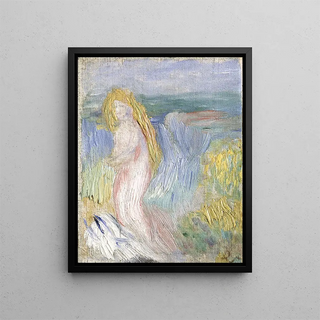Art print | Petite étude pour un nu - Pierre-Auguste Renoir


View from behind

Frame (optional)
The "Petite étude pour un nu" by Pierre-Auguste Renoir is a work that embodies the quintessence of Impressionist sensitivity. This painting, although modest in size, displays a richness of nuances and emotional depth that captivate the viewer. Renoir, master of light and color, manages to transcend the simple representation of the human body to create a celebration of beauty and sensuality. The piece, through its delicate forms and warm tones, invites the viewer to immerse themselves in a universe where art becomes a dialogue between the artist and the model—a silent yet powerful conversation.
Style and uniqueness of the work
Renoir's style in this study is characterized by a fluid touch and a palette of vibrant colors. The contours of the nude body are rendered with a lightness that seems almost ethereal, each brushstroke demonstrating incredible technical mastery. The artist plays with light, making it dance across the model's skin, creating reflections that add an almost tactile dimension to the painting. This work stands out for its ability to evoke flesh without ever falling into vulgarity. On the contrary, Renoir manages to capture an essence of femininity, a pure beauty that resonates with touching intimacy. The composition, though simple, is highly effective, with each element carefully designed to serve the artistic purpose.
The artist and his influence
Pierre-Auguste Renoir, an emblematic figure of the Impressionist movement, left an indelible mark on art history. His innovative approach paved the way for a new way of perceiving and representing the world. Renoir did not merely reproduce reality; he sought to grasp its essence, to capture fleeting emotions and moments of life. His artistic vision influenced many contemporary and future artists, notably through his bold use of color and his approach to light. The "Petite étude pour un nu" is part of this quest for beauty and expression, bearing witness to a constant dialogue between art and human nature. Renoir, through his gaze, invites us

Matte finish

View from behind

Frame (optional)
The "Petite étude pour un nu" by Pierre-Auguste Renoir is a work that embodies the quintessence of Impressionist sensitivity. This painting, although modest in size, displays a richness of nuances and emotional depth that captivate the viewer. Renoir, master of light and color, manages to transcend the simple representation of the human body to create a celebration of beauty and sensuality. The piece, through its delicate forms and warm tones, invites the viewer to immerse themselves in a universe where art becomes a dialogue between the artist and the model—a silent yet powerful conversation.
Style and uniqueness of the work
Renoir's style in this study is characterized by a fluid touch and a palette of vibrant colors. The contours of the nude body are rendered with a lightness that seems almost ethereal, each brushstroke demonstrating incredible technical mastery. The artist plays with light, making it dance across the model's skin, creating reflections that add an almost tactile dimension to the painting. This work stands out for its ability to evoke flesh without ever falling into vulgarity. On the contrary, Renoir manages to capture an essence of femininity, a pure beauty that resonates with touching intimacy. The composition, though simple, is highly effective, with each element carefully designed to serve the artistic purpose.
The artist and his influence
Pierre-Auguste Renoir, an emblematic figure of the Impressionist movement, left an indelible mark on art history. His innovative approach paved the way for a new way of perceiving and representing the world. Renoir did not merely reproduce reality; he sought to grasp its essence, to capture fleeting emotions and moments of life. His artistic vision influenced many contemporary and future artists, notably through his bold use of color and his approach to light. The "Petite étude pour un nu" is part of this quest for beauty and expression, bearing witness to a constant dialogue between art and human nature. Renoir, through his gaze, invites us






